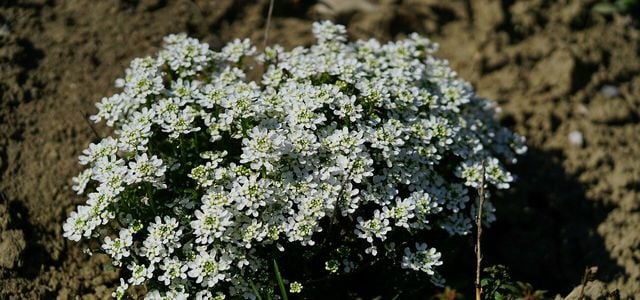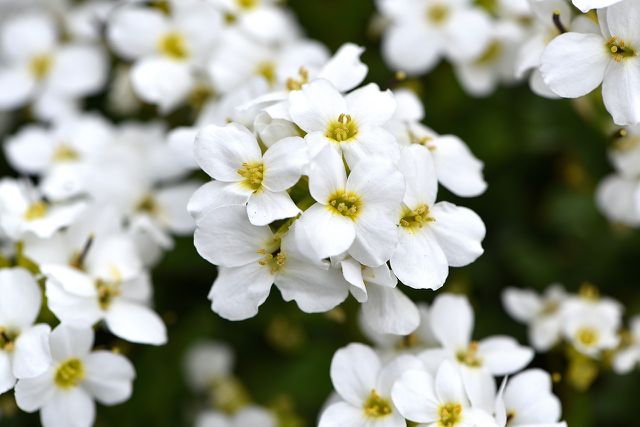
Fragrant stonewort not only has a pleasant fragrance, but is also easy to care for. In this article, we’ll show you how to plant and care for scented stonewort in your garden.
Fragrant stonewort (Lobularia maritima) belongs to the cruciferous family (Brassicaceae), which provides a large number of our current useful plants. It originates from the Mediterranean region and is also known as beach silverweed or beach cress in German-speaking countries. In the meantime, however, the Duftsteinrich is not only represented in southern Europe, but can also be found in Germany.
The scented stonewort has its name not by chance – the small flowers of the plant spread a pleasant, slightly sweet scent. This fragrance is not only pleasant for humans, but also attracts various species of insects, such as bees. Its long flowering period, which lasts practically all summer, makes the fragrant stonewort an attractive plant in the home garden.
When does the sweet stonecrop bloom?
In its southern home, scented stonewort is a perennial and blooms nearly year-round. Due to the colder climate, the flowering time of the scented stonecrop in Germany is much shorter. Here, scented stonecrop is an annual plant, as it dies in winter due to its sensitivity to frost.
In our country, Fragrant Coneflower blooms rather late in the year – you can see the small flowers, which can be white, pink or purple, from June until September or October.
Contents
This is what it needs
Growing fragrant ibex in your garden is relatively uncomplicated. The plant is very frugal and requires little care. If you don’t have a garden, you can also grow it as a balcony plant in a balcony box. Ideally, choose a sunny spot. If in doubt, the plant will also thrive in a semi-shady place. Completely shady places should be avoided.
The fragrant stonecrop also has rather few soil requirements. The plant prefers a rather nutrient-poor subsoil, which is water-permeable and not too wet. For example, you can take garden soil and mix it with some sand to reduce the nutrient content.
Fragrant stonecrop – How to grow it

Once you have found a suitable location, you have several options. You can either preplant the seeds in March or plant them directly outdoors in April. If you want to preplant the seeds, proceed as follows:
- Take an old egg carton and fill the indentations with peat-free soil.
- Place a few seeds per indentation and cover lightly with soil.
- Place the egg carton on the windowsill or in another sunny spot in your home (for example, conservatory). The seeds should germinate after a short time and the plant should begin to thrive.
- Keep your seedlings slightly moist and sprinkle them with a little water as soon as the soil starts to get dry.
- Wait until the frosty days are over and then plant them in the place you have prepared in your garden. To do this, loosen up some soil and add your planting soil along with some sand to the soil. Then insert the pre-pulled plants and press them down with some soil.
- Make sure that the planting distance is about 20 centimeters, because the plants will spread after some time.
If you prefer to sow directly outdoors, wait until at least April and then proceed as follows:
Prepare the place in the garden. Loosen the soil and plant the seeds. Make sure there is enough space (about 20 centimeters) and cover it only with a little soil.
- Keep the soil moist, but avoid waterlogging.
- If you have chosen balcony boxes, the procedure is the same (except for loosening the soil).
Tip: It looks most beautiful if you buy and plant the scented stonecrop in different colors. This will give your garden or balcony a very special color splendor
Fragrant stonewort – How to care for it
The care of fragrant stonewort is very manageable:
Perfumed ibex, which is grown in the garden, should only be watered during prolonged drought. You do not need to fertilize the scented stonecrop in the garden. However, pruning is an exception: When the flowering of the fragrant stonewort is no longer so intense and the flowering joy decreases, you can shorten the fragrant stonewort by about half with the secateurs. This will crank up growth and a second bloom. Pruning is not mandatory, but is done by many gardener’s. If you decide to prune, you can use liquid fertilizer. When buying the liquid fertilizer, make sure that it is organic.
If you have planted the fragrant stonewort on the balcony, you will have to water it more often, as there is less soil here and the plant cannot access deeper layers of soil. So make sure that the soil does not dry out when you plant fragrant ibex in a balcony box.
Fragrant ibex, as already described above, is an annual plant. However, it self-propagates and thus grows from year to year in the same place, or at least in close proximity.
The seeds are more frost-resistant than the plants, and thus get through the winter under the ground. The next year, a new fragrant stonewort emerges in the same spot. As winter approaches, you can either leave the faded fragrant ibex in the ground or pull it out and dispose of it in any compost you may have created. It is best to shake it vigorously again so that the last seeds from the plant fall into the soil.
In the balcony box you can take out the withered plants. Shake the plants again vigorously so that the remaining seeds fall into the soil of the balcony boxes. Then next year you will enjoy the new plants in your box.
Fragrant ibex is basically very hardy and resistant to pests. However, snails like to feed on the shoots of the fragrant stonewort. Here it may be advisable to keep an eye on it and pick off the snails if necessary.
A diverse garden contributes to biodiversity and provides food for many insects. The fragrant stonewort not only has a pleasant scent, which attracts a wide variety of insects, but is also very easy to care for. It is therefore very suitable as a flowering plant for your own garden or balcony.









